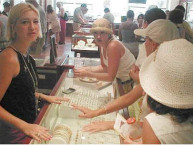Carat Weight | Clarity | Color | Cut
Carat Weight
All gemstones are sold by their weight. This is measured in carats. But exactly why is it called a carat??? Actually the word Carat is derived from carob, the bean that is often used as a chocolate substitute. Carob trees grow in the Mediterranean region, and in ancient times a diamond of one carat, or carob, was equal in weight to a single bean, or seed, of the carob tree. In the Far East, rice was used— four grains equaled one carob bean. Eventually the carat was standardized at 200 milligrams (1/5 of a gram), and the grain was standardized at 50 milligrams. Sometimes you will hear a diamond dealer refer to a one-carat diamond as a four grainer.
Any gemstone that you are considering for purchase should be marked with its carat weight. Simply buying gemstones by the millimeter size is popular in some stores but it does not give you an accurate representation of the size of the stone you are buying. Whenever you purchase a gemstone make sure that you receive, in writing, the proper carat weight of the stone.
Diamond weights are also referred to in points. One carat equals 100 points, so a 75-point diamond would weigh 3/4 of one carat. (Its not a diamond with 75 points on it, as some people think!)
Again, ask questions of your jeweler, all jewelry should be clearly marked.
Clarity
Gemstone clarity will affect value at different levels in different gemstones. In diamonds, even the smallest inclusion can result in a significantly lower price than a stone without the inclusion. In colored gemstones, however, the matter of a small inclusion is generally not regarded as important in most stones. In fact, some gemstones will be viewed with a great deal of suspicion without the presence of at least some inclusions. Examples are emerald, ruby, peridot, sapphire, and garnet.
An inclusion is any object within a stone that is not part of the original crystal structure of the gemstone. These can be other crystals that were caught in the gemstone as it grew, gas and/or air bubbles, or even bits of non-crystallized material. The important thing to remember here is that gemstones have color directly as the result of impurities in their crystal structure. And since most of these impurities show themselves as inclusions in colored stones, you should always remember that virtually all colored gemstones will naturally have inclusions.
Diamonds are rated as follows:
FL = Flawless
IF = Internally Flawless — minor surface blemishes
VVS1-VVS2 = very, very small inclusions
VS1-VS2 = very small inclusions
SI1-SI2 = small inclusions
I1-I2-I3 = Imperfect — I1- inclusions visible to the eye.
I2-inclusions start to affect beauty
I3- inclusions affect beauty and may pose a threat to structural integrity.
 Your diamonds certification papers may include a plotting chart of the inclusions of your diamond. GIA standards are strictly adhered to by CGI when plotting a loose diamond. All inclusions are plotted in red ink, blemishes in green ink, and extra facets and prongs in black ink. Note the illustration below, the small dots and flecks are written in by the gemologist on the certificate. No two diamonds are exactly alike so your plotting is the “fingerprinting” of your diamond, a very nice security factor.
Your diamonds certification papers may include a plotting chart of the inclusions of your diamond. GIA standards are strictly adhered to by CGI when plotting a loose diamond. All inclusions are plotted in red ink, blemishes in green ink, and extra facets and prongs in black ink. Note the illustration below, the small dots and flecks are written in by the gemologist on the certificate. No two diamonds are exactly alike so your plotting is the “fingerprinting” of your diamond, a very nice security factor.

Color
“Diamonds have color??? I thought they were colorless” Colorless diamonds are extremely scarce in nature. Graduations from high white to beginning yellows are not easily perceptible to an unpracticed eye. The exceptions to high value equaling colorless stones lie in the fancy, bright-colored diamonds i.e. amber, red, blue, etc. These diamonds, in the larger sizes, command enormous prices and are quickly snatched up by collectors worldwide.
Diamond color is graded across a scale, from a perfect colorless D to a markedly colored Z. Almost any diamond will show a slight trace of color, except for the very top grades, which are both rare and very expensive. And considering that the group of upper grades all appear colorless to most I suggest that a good value on the sliding scale of color places on right at “G” for the best “look” at the “best price”….

For all practical purposes, diamonds graded from D through F are considered colorless. While subtle graduations from D through F do exist, and are measurable by a gemologist (using ideal lighting conditions on a white background), to all but the trained eye these stones appear colorless.
Most diamonds sold are in the G through J range. While the untrained eye still sees these stones as colorless when mounted, they are graded as slightly tinted. “J” being more pronouncedly colored or tinted than a “G” color, most stores stock stones in this range, and order in higher grades as required. They don’t pay those prices for the “highest grades” so why should you! If you stay up toward the “G” range you’re going to find the best value and beauty for your money!
Diamonds graded from K through M show to the naked eye marked color, and are classified as faintly tinted or colored. Now this is where you really start seeing color “big time!” A stone of this range hammerset into a warm 18Kt yellow gold ring looks stunning; however, place it into a platinum or white gold set and it looks terribly colored! From N on towards Z colors are increasingly more dramatic.
“What about buying colored gemstones?”
As mentioned earlier, no colored gemstone would have color without the presence of impurities in its crystal structure. As a result, virtually every gemstone that shows a nice color may have inclusions. Examples are emerald, pink tourmaline, and ruby.
The most important consideration when shopping for a colored stone will be…color. When shopping for colored gemstones it will be important that you view the stone from all directions. The more valuable gemstones will have colors that are uniform in all directions with no dark or light bands of color, nor any zones of darker or lighter color. This uniformity of color should be very important with your shopping. A gemstone that shows marked areas of darker or lighter colors should be priced lower than gemstones with even color saturation.
Always remember that color is the most important consideration when colored gemstone shopping. Don’t turn down a gemstone showing nice color simply because of a minor cutting error or some inclusions that you can see. Color is the most important factor and should out weigh all other grading factors as long as the beauty of the stone is not affected.
When shopping for a colored gemstone you should be aware of the level of acceptable clarity that the particular gemstone will offer. Some stones, for instance emerald and pink tourmaline, will almost all have some type of inclusions. While others, such as amethyst and green tourmaline, should generally be free of inclusions. As you read the individual sections on the gemstones you will learn the acceptable levels of clarity per stone.
Cut or Proportioning
This term is used to describe how well a gemstone is cut. A well cut gemstone, both diamond and colored stone, should be cut in such a manner to present the stone’s best color and brilliance to its wearer. Often, since gemstones are sold by weight, many cutters will cut a stone is such a manner to keep the most weight instead of the most beauty. This will show itself in uneven facets, bulging sides, or colors that do not appear to show the best when viewed through the table of the stone. You can even see right through some stones because they have been cut in such a manner that leaves a window in the stone.
A good cut is determined by the stones light-reflecting properties and its light dispersion. This is the fire, brilliance, and personality the diamond projects to the wearer that has kept it so popular at the jewelry stores.
Proportion is the single most important factor, because it determines the flow of light more than other quality factors. Proportions that are too deep or too shallow both allow light to leak out the bottom and lessen the amount of light reflecting back to your eye.

Diamond proportions have changed over the last century. Consumers are more demanding and cutters are becoming more educated on the science of gems. A really great Diamond cutter is an artist, and they can coax the brilliance, dazzle and fire out of that piece of Diamond rough. Remember sitting in Algebra and Geometry class thinking you’d never use this stuff for anything more than laying carpet? Look closely at the diamond your about to buy and you’ll know if that cutter was paying attention in class. Its all in the angles.
Proportions determine a diamond’s brilliance (amount of light reflected back to your eye), fire (the flashes of color due to prism separation into the colors of the rainbow) and scintillation (sparkling movement of light as you move the diamond).
The table below illustrates a round diamond of excellent proportions. The results of this cut is a diamond which displays brilliance, fire and scintillation. Hopefully the skillful cutter of this diamond would be certain this would receive a fine polish. This will add the necessary sparkle quality. A dull polish on this diamond would leave it looking fuzzy and dull.

Over the years, with Diamond buyers becoming more skillful, consumers more educated, and the world becoming more “brand conscious” it is not surprising that the Diamond Industry has developed a line of “ultimate diamonds.”  These are diamonds with precise facet alignment, with crown and pavilion angles, bezel, star, upper girdle and pavilion all fitting into a precise pattern. The design is then marketed as an Ideal Cut Diamond. You may have seen these diamonds by the names of Hearts and Arrows, Hearts on Fire, Eight Star .
These are diamonds with precise facet alignment, with crown and pavilion angles, bezel, star, upper girdle and pavilion all fitting into a precise pattern. The design is then marketed as an Ideal Cut Diamond. You may have seen these diamonds by the names of Hearts and Arrows, Hearts on Fire, Eight Star .
Due to the precision of the pattern of each diamond it is also more time consuming to cut. Because it is so labor intensive the diamond cutters tend to pick out only the higher grade of diamonds. Add all of this together and you have a higher priced stone. It will be absolutely outstanding to look at, however it will be at a premium price.
Buy the stone and not the Paper
Consumers are becoming more and more educated about their Diamond and Gemstone purchases. This is a good thing. However one trend which is very disturbing are those who rely totally on the stones certification papers to guide their purchase decision. ” It looks good on paper ”
Diamonds and Gemstones are gifts of nature that grew in the ground, developed and have their own distinct personalities, flaws and fingerprints. Just like the fellow interviewing 10 people for a job, you can’t just read the resume to hire them. Its human nature that you have to meet them, shake their hand, interview them, and experience their personality. Its during this process that he’ll “just know” which is the best.
Take the time to look at the Gemstones and Diamond you may be purchasing. Pick them up in your hand, hold them up to different lights, and experience them. There are no right or wrong decisions when choosing a gem. You will “just know” when one comes along that interacts well with you. Then confirm your good taste by inspecting its quality report. If it meets with your approval, you can be assured you have made a wise decision.



